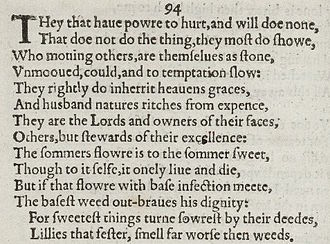Sonnet 94
| Sonnet 94 | |||||||
|---|---|---|---|---|---|---|---|
 Sonnet 94 in the 1609 Quarto | |||||||
| |||||||
Sonnet 94 is one of 154 sonnets written by the English playwright and poet William Shakespeare. It is a member of the Fair Youth sequence, in which the poet expresses his love towards a young man.
Structure[]
Sonnet 94 is an English or Shakespearean sonnet. The English sonnet has three quatrains, followed by a final rhyming couplet. It follows the typical rhyme scheme of the form, ABAB CDCD EFEF GG, and is composed in iambic pentameter, a type of poetic metre based on five pairs of metrically weak/strong syllabic positions. The 6th line exemplifies a regular iambic pentameter:
× / × / × / × / × / And husband nature's riches from expense; (94.6)
The 7th line exhibits two fairly common metrical variations: an initial reversal, and a final extrametrical syllable or feminine ending:
/ × × / × / × / × /(×) They are the lords and owners of their faces, (94.7)
- / = ictus, a metrically strong syllabic position. × = nonictus. (×) = extrametrical syllable.
Line 5 necessarily shares a feminine ending. Initial reversals also appear in lines 1, 8, and 14.
The meter demands a few variant pronunciations: line 1's "power" functions as 1 syllable, line 4's "unmovèd" as 3, and lines 9 and 11's "flower" as 1.[2]
Context[]
Sonnet 94 forms part of the "Fair Youth" sequence, where in sonnets 87-96 the Youth is seen as potentially fickle and unreliable. In 90-93 the Youth seems ready to abandon the poet and forget past promises; it is possible that some act or failure to act, or some statement, in the real-life circle of the Youth's admirers has convinced the poet that his beloved is one of those who moves others but is himself "as stone", giving a false impression of his intentions. Therefore there are grounds for cautious optimism, or so the poet thinks, for the Youth may in fact remain faithful despite past suspicions. Yet there remains the thought that some evil will still destroy the poet's hopes, and optimism may prove unfounded.[3]
References[]
- ^ Pooler, C[harles] Knox, ed. (1918). The Works of Shakespeare: Sonnets. The Arden Shakespeare [1st series]. London: Methuen & Company. OCLC 4770201.
- ^ Booth 2000, p. 83.
- ^ Shakespeare's sonnets
Further reading[]
- First edition and facsimile
- Shakespeare, William (1609). Shake-speares Sonnets: Never Before Imprinted. London: Thomas Thorpe.
- Lee, Sidney, ed. (1905). Shakespeares Sonnets: Being a reproduction in facsimile of the first edition. Oxford: Clarendon Press. OCLC 458829162.
- Variorum editions
- Alden, Raymond Macdonald, ed. (1916). The Sonnets of Shakespeare. Boston: Houghton Mifflin Harcourt. OCLC 234756.
- Rollins, Hyder Edward, ed. (1944). A New Variorum Edition of Shakespeare: The Sonnets [2 Volumes]. Philadelphia: J. B. Lippincott & Co. OCLC 6028485.
- Modern critical editions
- Atkins, Carl D., ed. (2007). Shakespeare's Sonnets: With Three Hundred Years of Commentary. Madison: Fairleigh Dickinson University Press. ISBN 978-0-8386-4163-7. OCLC 86090499.
- Booth, Stephen, ed. (2000) [1st ed. 1977]. Shakespeare's Sonnets (Rev. ed.). New Haven: Yale Nota Bene. ISBN 0-300-01959-9. OCLC 2968040.
- Burrow, Colin, ed. (2002). The Complete Sonnets and Poems. The Oxford Shakespeare. Oxford: Oxford University Press. ISBN 978-0192819338. OCLC 48532938.
- Duncan-Jones, Katherine, ed. (2010) [1st ed. 1997]. Shakespeare's Sonnets. The Arden Shakespeare, Third Series (Rev. ed.). London: Bloomsbury. ISBN 978-1-4080-1797-5. OCLC 755065951.
- Evans, G. Blakemore, ed. (1996). The Sonnets. The New Cambridge Shakespeare. Cambridge: Cambridge University Press. ISBN 978-0521294034. OCLC 32272082.
- Kerrigan, John, ed. (1995) [1st ed. 1986]. The Sonnets ; and, A Lover's Complaint. New Penguin Shakespeare (Rev. ed.). Penguin Books. ISBN 0-14-070732-8. OCLC 15018446.
- Mowat, Barbara A.; Werstine, Paul, eds. (2006). Shakespeare's Sonnets & Poems. Folger Shakespeare Library. New York: Washington Square Press. ISBN 978-0743273282. OCLC 64594469.
- Orgel, Stephen, ed. (2001). The Sonnets. The Pelican Shakespeare (Rev. ed.). New York: Penguin Books. ISBN 978-0140714531. OCLC 46683809.
- Vendler, Helen, ed. (1997). The Art of Shakespeare's Sonnets. Cambridge, MA: The Belknap Press of Harvard University Press. ISBN 0-674-63712-7. OCLC 36806589.
- British poems
- Sonnets by William Shakespeare

